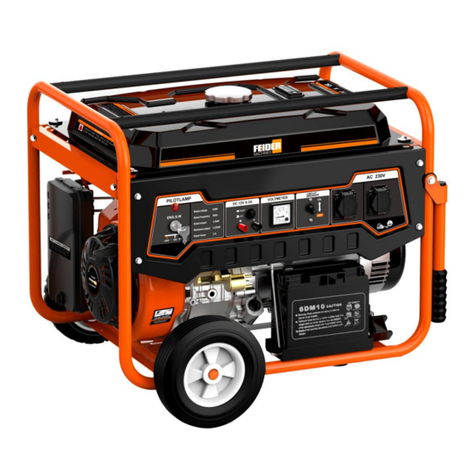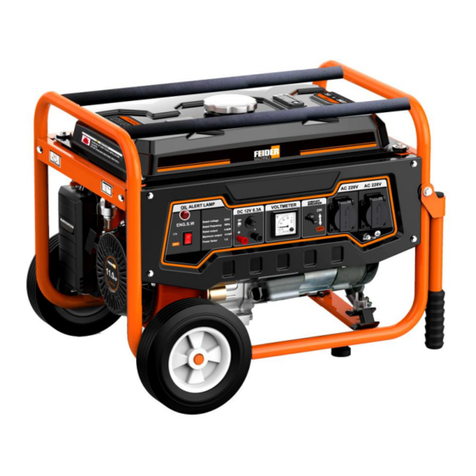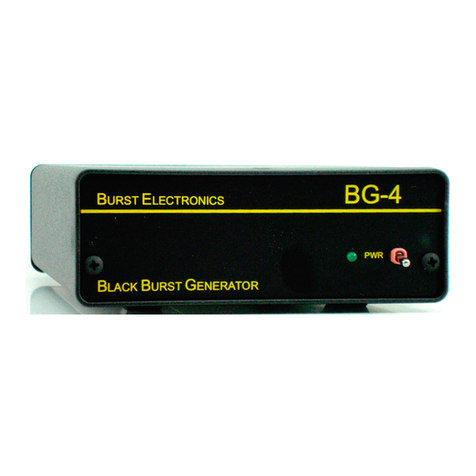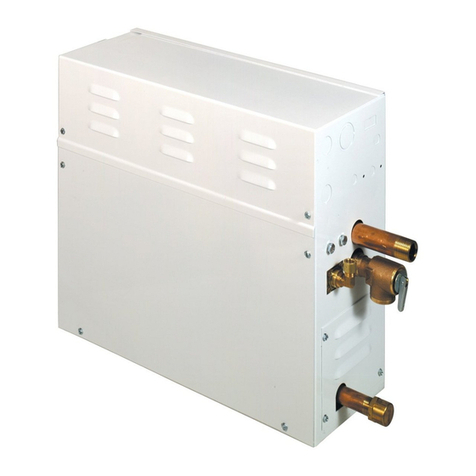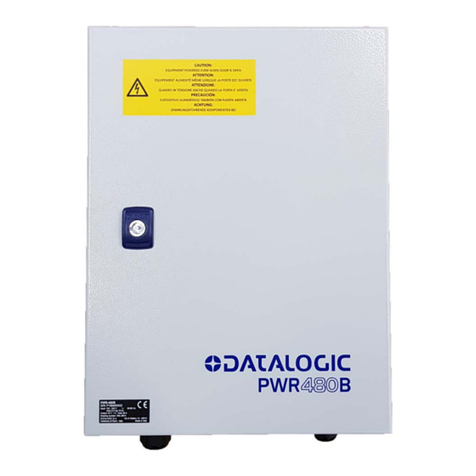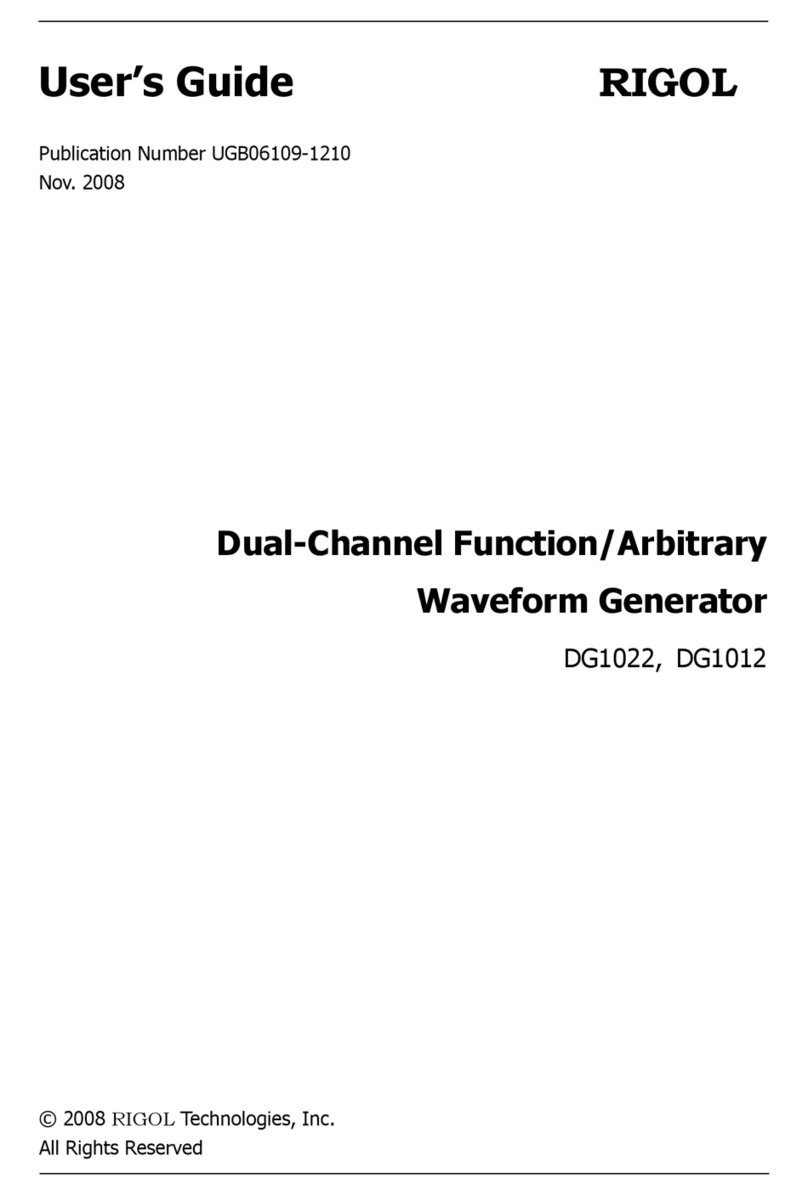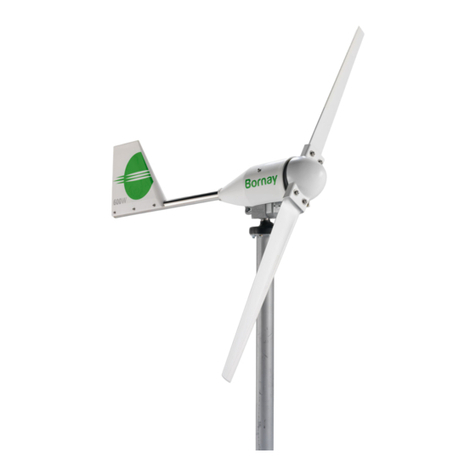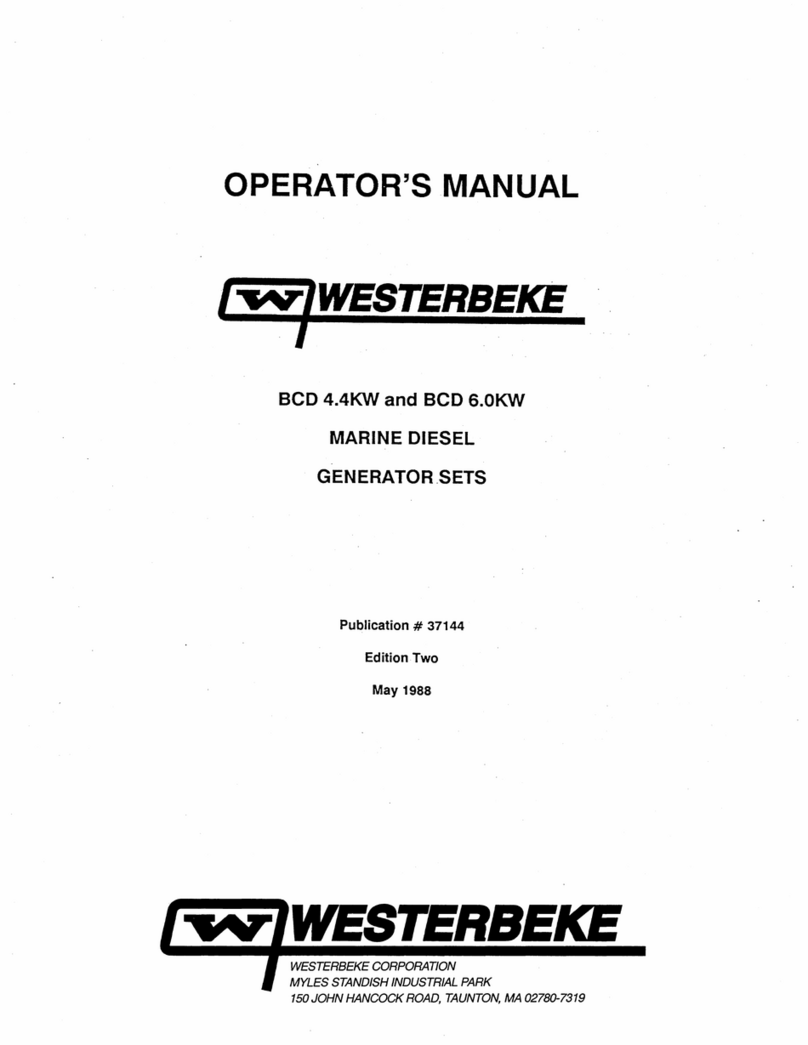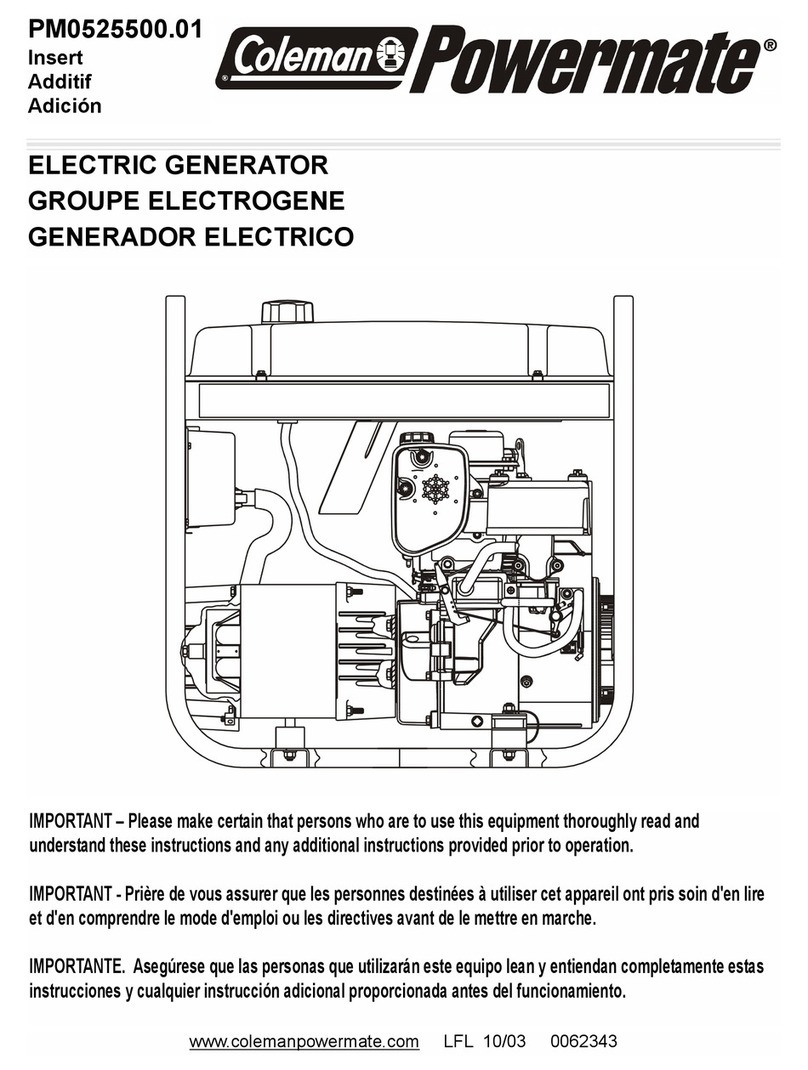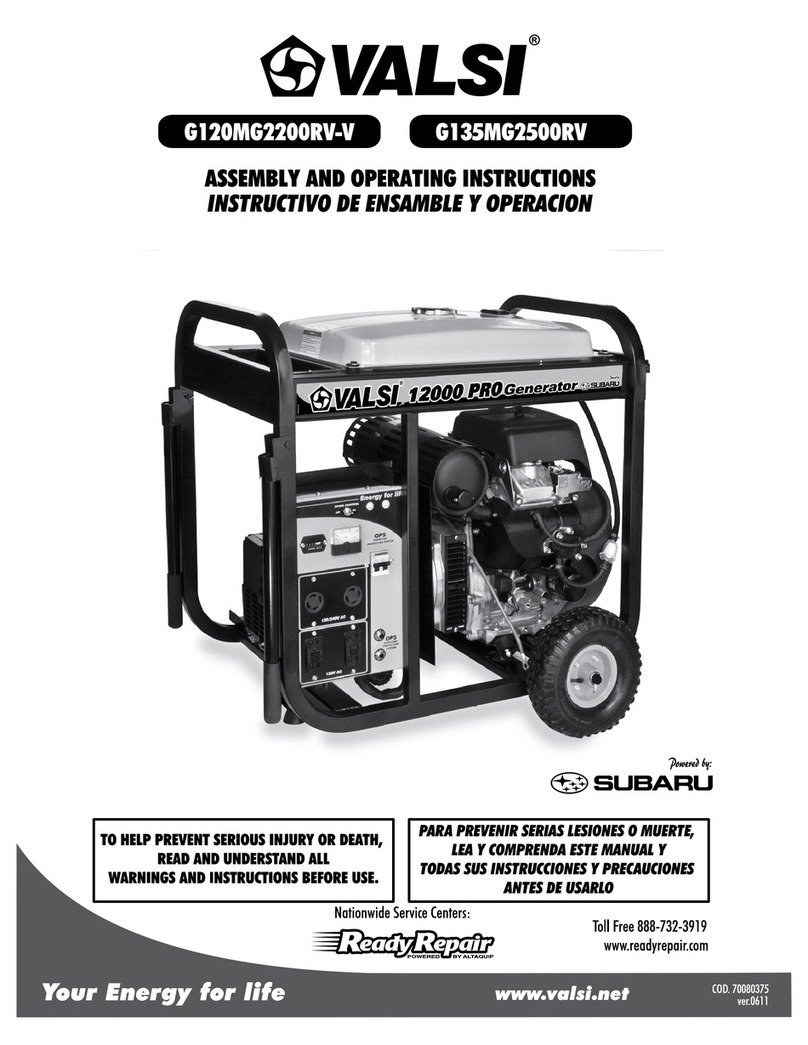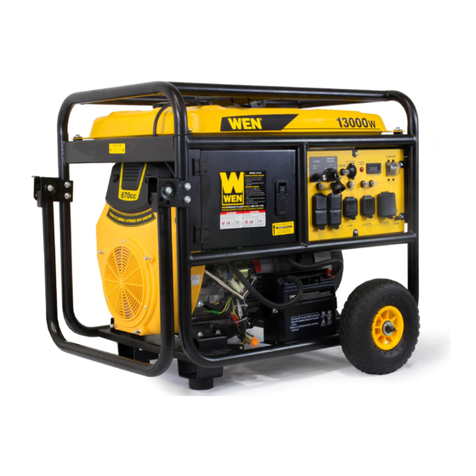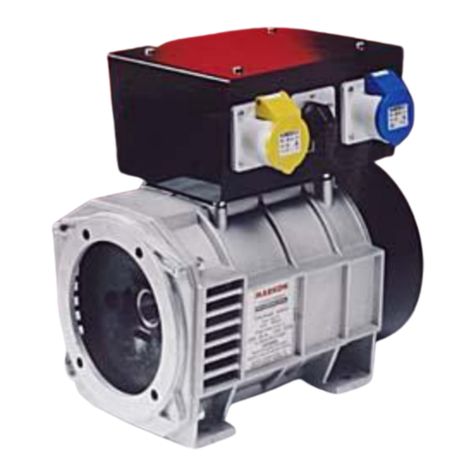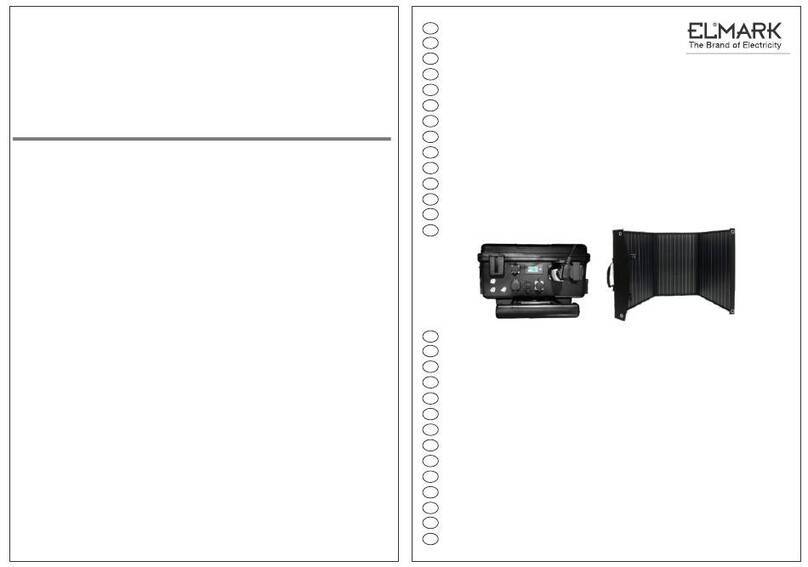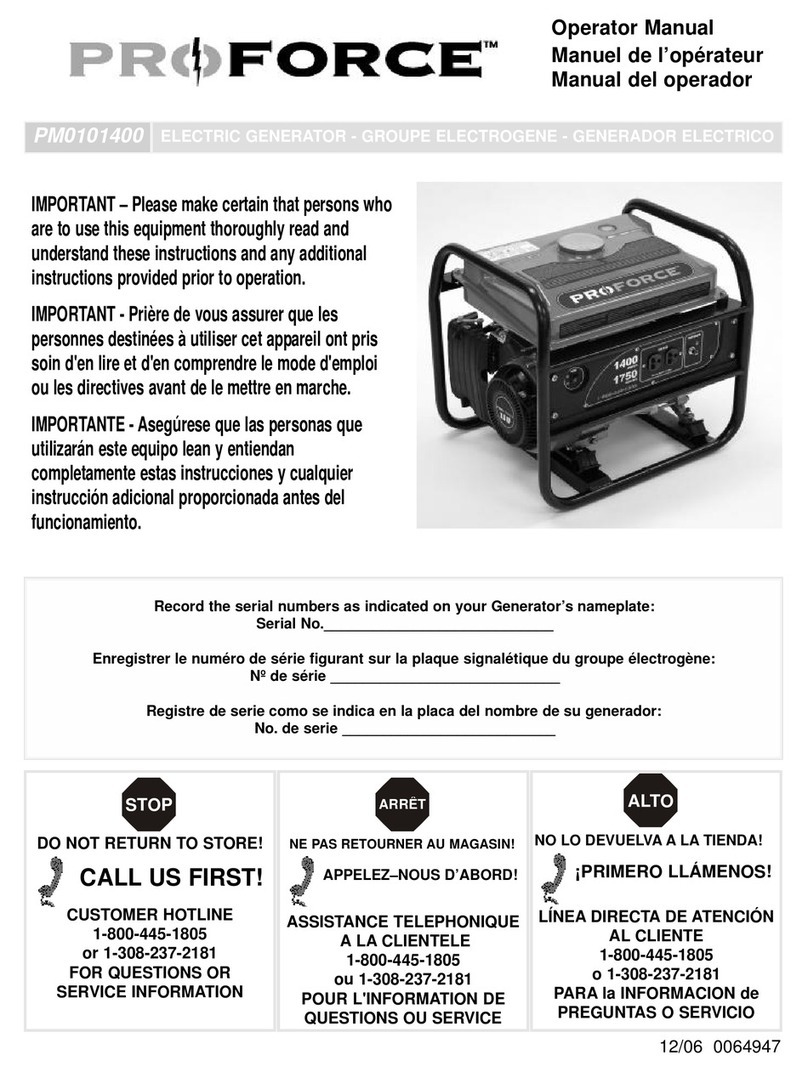Feider Machines FG3000-A User manual

ORIGINAL INSTRUCTIONS >EN
GASOLINE GENERATOR
FG3000-A
USER GUIDE
CAUTION: Read the instructions before using the product.

CONTENTS
1. SAFETY INSTRUCTION 3
2. COMPONENT IDENTIFICATION 7
3. ASSEMBLY 8
4. CONTROLS 8
5. GENERATOR USE 10
6. PRE-OPERATION CHECK 13
7. STARTING / STOPPING THE ENGINE 15
8. MAINTENANCE 16
9. TRANSPORTING AND STORAGE 20
10. TROUBLESHOOTING 22
11. WIRING DIAGRAM 23
12. SPECIFICATIONS 24
13. EC DECLARATION OF CONFORMITY 25
14. WARRANTY 26
15. PRODUCT FAILURE 27
16. WARRANTY EXCLUSIONS 28

1. SAFETY INSTRUCTION
Warning:
1. Attention! Exhaust gases are toxic. Do not operate the generator in a room without
ventilation system!
2. Children should be protected by keeping them at a safe distance from the generator set!
3. Refilling of the generating sets is not allowed during the operation!
4. If the generator will be mounted in a closed room, relevant safety regulations against fire and
explosion should be followed!
5. Do not connect to household circuit!
6. Do not use in wet condition!
7. Keep in flammable away!
8. When refueling:
a) stop engine;
b) no smoking;
c) Do not spill.
1.1 GENERAL SECURITY INSTRUCTIONS
The operator must know the principles of functioning and the structure of the generator and the
motor. He must know how to stop the motor in case of urgency and how to manipulate the controls.
Never let children use this device.
Never let people who do not know these instructions use this device. Local regulations may impose
restrictions on the age of the user.
Please do not use this device when people, especially children, or pets are nearby. Direct them
away from the working area.
The operator or the user are responsible for possible accidents or damage to other persons or to
their property.
Do not wear loose clothing or jewellery as this can get caught in the machinery as it runs.
Use safety equipment. Wear protective gear such as an anti-dust mask, non-slip safety shoes, and
a helmet or hearing protection.
Stay vigilant, watch what you are doing and show good sense when you use the generator. Do not
use if you are tired or under the influence of drugs, alcohol or medicines.
Install the generator in a place that is well ventilated and make sure that there is at least 1.5 meters
between the generator and the walls of the building or other equipment. Do not place flammable
liquids or gases near the generator.
Do not run the generator in an enclosed or badly-ventilated space. The exhaust gas from the motor
contains carbon monoxide which is toxic and may lead to a loss of consciousness or death.
Run the generator in respect of the power indicated in the user’s manual. Do not run the generator
with an overload or at excessive speed.
The silencer of the generator becomes extremely hot when the motor runs or even for a time after it
has stopped. Do not touch it as it will burn you.
Do not transport or move the generator until it has cooled down.

Perform periodic maintenance and resolve problems that appear immediately. Do not run the
generator before correcting any fault detected.
The generator uses a system of air-cooling, and it is necessary to clean its components regularly,
including the grilles, the cover of the fan and the fan itself so as to ensure cooling.
Keep the fuel filter clean, and change the oil of the motor regularly.
Periodically check the installation of the connections and the tightness of the fixations, re-tightening
them if necessary.
Clean the components of the air filter periodically, and replace the air filter when necessary.
Remove any electrical equipment that is plugged in before starting or stopping the generator.
Before transporting the generator, you must empty the fuel tank.
Maintenance and repair of the generator must be carried out by a qualified technician from an
authorized after-sales service center.
Warning: when you start the generator with the cord, watch out for sudden changes in the rotation of the
motor!!! Risk of wounding!!! Never cover the generator when it is running. The cut-out mounted on the
generator has the aim of reducing the risk of electric shock. If it needs to be replaced with another cut-out,
the latter must correspond to the technical specifications of the generator. Due to important mechanical
constraints, it is necessary to use a flexible sheathed cable with a strong rubber protective layer
(conforming to IEC 245-4) or a similar cable. If using an electrical extension cable, the total length of the
extension must not exceed 60m when the section of the wire is 1.5mm2and must not exceed 100m when
the section of the wire is 2.5mm2.
1.2 ADDITIONAL REQUIREMENTS FOR LOW-POWER
GENERATING SETS FOR USE BY LAYMEN
Protect children by keeping them at a safe distance from the generating set.
Fuel is combustible and easily ignited. Do not refuel during operation. Do not refuel while smoking
or near naked flames. Do not spill fuel.
Some parts of the internal combustion engine are hot and may cause burns. Pay attention to the
warnings on the generating set.
Engine exhaust gases are toxic. Do not operate the generating set in unventilated rooms. When
installed in ventilated rooms, additional requirements for fire and explosion protection shall be
observed.
Before use, the generating set and its electrical equipment (including lines and plug connections)
should be checked to ensure that they are not defective.
Protection against electrical shock depends on circuit breakers specially matched to the generating
set. If the circuit breakers require replacement, they should be replaced with a circuit breaker having
identical ratings and performances characteristics.
Due to high mechanical stresses, only tough rubber-sheathed flexible cable (in accordance with IEC
60245-4) or the equivalent should be used.
The user shall conform to regulations of electrical safety applicable to the place where the
generating sets are used.

The user must respect the requirements and precautions in the case of resupply by generating sets
of an installation, depending on existing protective measures in this installation and applicable
regulations.
Generating sets should only be loaded up to their rated power under the rated ambient conditions.
Prior to commencing maintenance work it shall be ensured that untimely start-up is not possible.
1.3 SECURITY MEASURES WHEN FILLING THE FUEL TANK
The fuel is extremely flammable and poisonous.
This generator only uses petrol (gasoline); any other kind of fuel will damage the motor.
Do not overfill the tank with petrol to avoid spilling. If you notice a spill, it must be wiped up
completely with a dry cloth before starting the motor.
If you swallow fuel by mistake, if you inhale fuel vapors or if you get drops of fuel in your eyes, see a
doctor immediately. If a certain quantity of fuel is spilt on your skin or clothing, wash or change your
clothes.
Always stop the motor of the generator when filling it with fuel.
Never fill the fuel tank while smoking or near a naked flame.
Make sure you don’t spill fuel on the motor and the exhaust grille of the generator during filling with
fuel.
Keep the fuel in an appropriate recipient and sheltered from any sources of fire.
Carry out filling in a safe place, and slowly open the fuel cap to release the pressure which has built
up inside the tank. Wipe up any drops of petrol that have spilled before starting the motor.
To prevent fire, move the generator at least 4 meters away from the area for filling with fuel.
Make sure that the fuel cap is tightly closed before starting.
Do not keep petrol in the tank for a long time.
While using or transporting the generator, make sure you keep the generator upright,
otherwise the fuel may escape from the carburetor or the fuel tank.
1.4 ELECTRICAL SAFETY
Before each use ensure that the load to be connected does not exceed the power of the current
produced by the generator.
To avoid electric shock, you must follow the following instructions:
Do not touch the generator with wet hands.
Do not run the generator under rain or snow.
Do not run the generator near water.
Connect the generator to earth. Use a sufficiently thick conductor for the earth wire.
Do not operate the generator in parallel with another generator.
If using electrical extensions, make sure that they are sufficiently thick to transport the current and
that they are used correctly.
The connection of a generator used for auxiliary power to the electrical installation of a
building must be performed by a qualified electrician, and in conformity to the provisions of the

applicable laws and norms in the field of electricity. Incorrect connections will cause leakage of the
current from the generator into the lines of the public electricity company. Such leakage could
electrocute the workers of the public electricity company working on the network or other persons in
contact with the line during a power cut. Also, when the public power supply is re-established, the
generator can explode, catch fire or generate fires in the building’s electrical installation.
Before connecting electrical devices to the generator, make sure that their voltage
specifications and frequency of functioning correspond to the technical characteristics of the
generator. There may be damage if the device connected is not designed to function with a voltage
tolerance of +/- 10% or a frequency tolerance of +/- 3 % compared with those of the generator.
1.5 PROTECTION OF THE ENVIRONMENT
You must periodically check the silencer (Before doing this, switch off the generator and let it cool
completely). A damaged silencer increases noise.
Do not throw motor oil into the drains but deposit it at a collection point set up for that purpose.
The fuel for this machine is combustible and explosive. After stopping the machine, you must
handle the remaining fuel correctly and meet local environmental requirements.
To dispose of residual fluids, proceed as follows:
Close the fuel tap
Drain fuel from the fuel tank
Empty carburetor fuel
1.6 SYMBOL EXPLANATION
Attention!
Please read the manual carefully before using the unit!
Conforms to relevant safety standards
Do not dispose of old appliances with domestic rubbish
Add engine oil.
Guaranteed sound power level
No naked flames
Ground connection

Danger! Electrical shock!
Exhaust emissions are harmful to health of body
No naked fire near the machine!
This symbol indicates the surface is very hot and not touching
2. COMPONENT IDENTIFICATION
NOTE: Diagrams may vary according to the types.

3. ASSEMBLY
3.1 FEET
Place a foot under each support. Screw the foot with a screw and a nut.
Place the foot support under each side of the support bar (on the side where the starter grip is
located). Screw the brackets together with a screw and nut.
3.2 WHEELS
On the other side of the unit, insert the bar into the wheel mounting bracket.
Insert two washers on each side of the bar.
Place the wheels on either side of the bar. Insert a pin into each hole to secure the wheels.
3.3 HANDLES
The handles should be placed on each vertical bar above the starter grip.
Place one handle on one side of the bar (the holes must be aligned).
Screw it with a screw and a nut.
Do the same procedure on the other side.
4. CONTROLS
4.1 ENGINE SWITCH
To start and stop the engine:
Switch position:
OFF: To Stop the engine. The key can be removed/inserted
ON: To run the engine after starting.
START: To start the engine by turning the starter motor.
With Electric Starter Without Electric Starter
Return the key to the ON position once the engine has started. Do not use the starter for more
than 5 seconds at a time. If the engine fails to start, release the switch and wait 10 seconds before
operating the starter again.
4.2 RECOIL STARTER
To start the engine, pull the starter grip lightly until resistance is felt, then pull briskly.

NOTICE
Do not allow the starter to snap back against the engine. Return it gently to prevent
damage to the starter.
4.3FUEL VALVE
The fuel valve is located between the fuel tank and carburetor. When the valve lever is in the ON
position, fuel is allowed to flow from the fuel tank to the carburetor. Be sure to return the lever to
OFF after stopping the engine.
4.4 CHOKE
The choke is used to provide an enriched fuel mixture when starting a cold engine. It can be
opened and closed by operating the choke lever or choke rod manually. Move the lever or the rod
to the CLOSE position to enrich the mixture.
4.5 CIRCUIT BREAKER
The circuit breaker will automatically switch OFF if there is a short circuit or a significant overload
of the generator at the receptacle. If the circuit breaker is switched OFF automatically, check that
the appliance is working properly and does not exceed the rated load capacity of the circuit before
switching the circuit breaker ON again. The circuit breaker may be used to switch the generator
power ON or OFF.

4.6 GROUND TERMINAL
The generator ground terminal is connected to the panel of the generator, the metal non-current
carrying parts of the generator, and the ground terminals of each receptacle. Before using the
ground terminal, consult a qualified electrician, electrical inspector or local agency having
jurisdiction for local codes or ordinances that apply to the intended use of the generator.
4.7 OIL ALERT SYSTEM
The oil alert system is designed to prevent engine damage caused by an insufficient amount of oil
in the crankcase. Before the oil level in the crankcase can fall below a safe limit, the oil alert
system will automatically shut down the engine (the engine switch will remain in the ON position).
The oil alert system shuts down the engine and the engine will not start. If this occurs, check
engine oil.
5. GENERATOR USE
5.1 CONNECTIONS TO A BUILDING’S ELECTRICAL SYSTEM
Connections for standby power to a building's electrical system must be made by a qualified
electrician. The connection must isolate the generator power from utility power, and must comply
with all applicable laws and electrical codes.
WARNING
Improper connections to a building's electrical system, can allow electrical current from the
generator to feedback into the utility lines. Such feedback may electrocute utility company workers
or others who contact the lines during a power outage. Consult the utility company or a qualified
electrician.
CAUTION
Improper connections to a building’s electrical system can allow electrical current from the utility
company to feedback into the generator. When utility power is restored, the generator may
explode, burn, or cause fires in the building’s electrical system.
5.2 GROUND SYSTEM
To prevent electrical shock from faulty appliances, the generator should be grounded. Connect a
length of heavy wire between the ground terminal and the ground source. The generators have a
system ground that connects generator frame components to the ground terminals in the AC
output receptacles. The system ground is not connected to the AC neutral wire.
If the generator is tested by a receptacle tester, it will not show the same ground circuit condition
as for a home receptacle.

Special Requirements
There may be Federal or State Occupational Safety and Health Administration (OSHA) regulations,
local codes, or ordinances that apply to the intended use of the generator. Please consult a
qualified electrician, electrical inspector, or the local agency having jurisdiction.
• In some areas, generators are required to be registered with local utility companies.
• If the generator is used at a construction site, there may be additional regulations which must be
observed.
5.3 AC APPLICATIONS
Before connecting an appliance or power cord to the generator:
• Make sure that it is in good working order. Faulty appliances or power cords can create a
potential for electrical shock.
• If an appliance begins to operate abnormally, becomes sluggish or stops suddenly, turn it off
immediately. Disconnect the appliance, and determine whether the problem is the appliance, or if
the rated load capacity of the generator has been exceeded.
• Make sure that the electrical, rating of the tool or appliance does not exceed that of the generator.
Never exceed the maximum power rating of the generator. Power levels between rated and
maximum may be used for no more than 30 minutes.
NOTICE
Substantial overloading will switch off the circuit breaker.
Exceeding the time limit for maximum power operation or slightly overloading the
generator may not switch the circuit breaker OFF, but will shorten the service life of the
generator.
Limit operation requiring maximum power to 30 minutes. For continuous operation, do not exceed
the rated power. In any case, the total power requirements (VA) of all appliances connected must
be considered. Appliance and power tool manufacturers usually list rating information near the
model number or serial number.
5.4 AC OPERATION
①Start the engine
②Switch the AC circuit breaker ON.
③Plug in the appliance.
Most motorized appliances require more than their rated wattage for startup.
Do not exceed the current limit specified for any one receptacle. If an overloaded circuit causes
the AC circuit breaker to switch OFF, reduce the electrical load on the circuit, wait a few minutes
and then reset the circuit breaker.

5.5 DC OPERATION (IF AVAILABLE)
DC Terminals
The DC terminals may ONLY be used for charging 12 volt automotive type batteries. The
terminals are colored red to identify the positive (+) terminal and black to identify the negative (-)
terminal. The battery must be connected to the generator DC terminals with the proper polarity
(battery positive to generator red terminal and battery negative to the generator black terminal).
With DC Circuit Protector With DC Fuse
DC Circuit Protector (or DC Fuse)
The DC circuit protector (or DC Fuse) automatically shuts off the DC battery charging circuit when
the DC circuit is overloaded, when there is a problem with the battery, or the connections between
the battery and the generator are improper.
The indicator inside the DC circuit protector button will pop out to show that the DC circuit
protector has switched off. Wait a few minutes and push the button in to reset the DC circuit
protector.
Connecting the battery cables:
1) Before connecting charging cables to a battery that is installed in a vehicle, disconnect the
vehicle’s grounded battery cable.
WARNING
The battery gives off explosive gases; keep spark, flames and cigarettes away. Provide adequate
ventilation when charging or using batteries.
2) Connect the positive (+) battery cable to the battery positive (+) terminal.
3) Connect the other end of the positive (+) battery cable to the generator.
4) Connect the negative (-) battery cable to the battery negative (-) terminal.
5) Connect the other end of the negative (-) battery cable to the generator.
6) Start the generator.
NOTICE
Do not start the vehicle while the battery charging cables are connected and the generator
is running. The vehicle or the generator may be damaged.
An overloaded DC circuit will fuse the DC fuse, if this happens, replace fuse.
An overloaded DC circuit, excessive current draw by the battery, or a wiring problem will trip the
DC circuit protector (PUSH button extends out). If this happens, wait a few minutes before pushing
in the circuit protector to resume operation. If the circuit protector continues to go OFF, discontinue
charging and see your authorized generator dealer.
Disconnecting the battery cables:
1) Stop the engine.
2) Disconnect the negative (-) battery cable from the generator negative (-) terminal.
3) Disconnect the other end of the negative (-) battery cable from the battery negative (-) terminal.

13
4) Disconnect the positive (+) battery cable from the generator positive (+) terminal.
5) Disconnect the other end of the positive (+) battery cable to the battery positive (+) terminal.
6) Connect the vehicle ground cable to the battery negative (-) terminal.
7) Reconnect the vehicle grounded battery cable.
5.6 HIGH ALTITUDE OPERATION
At high altitude, the standard carburetor air-fuel mixture will be excessively rich. Performance will
decrease, and fuel consumption will increase.
High altitude performance can be improved by installing a smaller diameter main fuel jet in the
carburetor and readjusting the pilot screw. If you always operate the engine at altitudes higher
than 5000 feet (1500 meters) above sea level, have an authorized generator dealer perform this
carburetor modification.
Even with suitable carburetor jetting, engine horsepower will decrease approximately 3.5% for
each 1000 foot (300 meter) increase in altitude. The effect of altitude on horsepower will be
greater than this if no carburetor modification is made.
NOTICE
If an engine jetted for high altitude is used at a lower altitude, the lean air fuel mixture will
reduce performance and may over-heat and seriously damage the engine.
6. PRE-OPERATION CHECK
6.1 ENGINE OIL
Engine oil is a major factor affecting engine performance and service life. Non-detergent
and 2-stroke engine oils will damage the engine and are not recommended.
Check the oil level BEFORE EACH USE with the generator on a level surface with the engine
stopped.
Use 4-stroke oil, or equivalent high detergent, premium quality motor oil certified to meet or
exceed U.S. automobile manufacturer’s requirements for Service Classification SG, SF/CC, CD.
Motor oils classified SG, SF/CC, CD will show this designation on the container.
SAE 10W-30 is recommended for general temperature use. Other viscosities shown in the chart
may be used when the average temperature in your area is within the indicated range.
1. Remove the oil filler cap and wipe the dipstick clean.
2. Check the oil level by inserting the dipstick into the filler neck without screwing it in.
3. If the level is low, add the recommended oil to the upper mark on the dipstick.
NOTICE

6.2 FUEL RECOMMENDATION
1. Check the fuel level gauge.
2. Refill the tank if the fuel level is low. Do not fill above the shoulder of the fuel strainer.
WARNING
• Gasoline is extremely flammable and is explosive under certain conditions.
• Refuel in a well-ventilated area with the engine stopped. Do not smoke or allow flames or sparks
in the area where the engine is refueled or where gasoline is stored.
• Do not overfill the fuel tank (there should be no fuel in the filler neck). After refueling, make sure
the tank cap is closed properly and securely. Be careful not to spill fuel when refueling. Spilled fuel
or fuel vapor may ignite. If any fuel is spilled, make sure the area is dry before starting the engine.
• Avoid repeated or prolonged contact with skin or breathing of vapor.
• KEEP OUT OF REACH OF CHILDREN.
Use gasoline with a pump octane rating of 86 or higher.
We recommend unleaded gasoline because it produces fewer engine and spark plug deposits and
extends exhaust system life.
Never use stale or contaminated gasoline or oil/gasoline mixture. Avoid getting dirt or water in the
fuel tank.
Occasionally you may hear light “spark knock" or “pinging" (metallic rapping noise) while operating
under heavy loads. This is no cause for concern.
If spark knock or pinging occurs at a steady engine speed, under normal load, change brands of
gasoline. If spark knock or pinging persists, see an authorized generator dealer.
NOTICE
Running the engine with persistent spark knock or pinging can cause engine damage.
Running the engine with persistent spark knock or pinging is misuse, and the Distributor's Limited
Warranty does not cover parts damaged by misuse.

Oxygenated Fuels
Some gasoline is blended with alcohol or an ether compound to increase the octane. This gasoline
is collectively referred to as oxygenated fuels. Some areas of the United States use oxygenated
fuels to help meet clean air standards. If you use an oxygenated fuel, be sure its pump octane
rating is 86 or higher.
Ethanol (ethyl or grain alcohol)
Gasoline containing more than 10% ethanol by volume may cause starting or performance
problems. Gasoline containing ethanol may be marketed under the name “Gasohol".
Methanol (methyl or wood alcohol)
Gasoline containing methanol must contain solvents and corrosion inhibitors to protect the fuel
system. Gasoline containing more than 5% methanol by volume may cause starting and/or
performance problems and may damage metal, rubber and plastic parts of your fuel system.
MTBE (methyl tertiary butyl ether)
You may use gasoline containing up to 15% MTBE by volume. Before using an oxygenated fuel,
try to confirm the fuel’s contents. Some states (provinces in Canada) require this information to be
posted on the pump. If you notice any undesirable operating symptoms, switch to a conventional
unleaded gasoline. Fuel system damage or performance problems resulting from the use of an
oxygenated fuel are not ours responsibility and are not covered under warranty.
NOTICE
Oxygenated fuels can damage paint and plastic. Be careful not to spill fuel when filling your
fuel tank. Damage caused by spilled fuel is not covered under warranty.
7. STARTING/STOPPING THE ENGINE
7.1 STARTING THE ENGINE
1. Make sure that the AC circuit breaker is in the OFF position. The generator may be hard to start
if a load is connected.
2. Turn the fuel valve to the ON position.
3. Turn the choke lever or to the CLOSE position, or pull the choke rod out to the CLOSE position.
4. Start the engine
• With recoil starter:
Turn the engine switch to the ON position.
Pull the starter grip until compression is felt, then pull briskly.
NOTICE
Do not allow the starter grip to snap back against the engine. Return it gently to prevent
damage to the starter or housing.
• With electric starter: (Optional kit)
Turn the engine switch to the START position and hold it there for 5 seconds or until the engine
starts.
NOTICE
Operating the starter motor for more than 5 seconds can damage the motor. If the engine
fails to start, release the switch and wait 10 seconds before operating the starter again. If
the speed of the starter motor drops after a period of time, it indicates that the battery
should be recharged.
When the engine starts, allow the engine switch to return to the ON position.
1. Turn the choke lever or push the choke rod to the OPEN position as the engine warms up.

7.2 STOPPING THE ENGINE
In an emergency:
To stop the engine in an emergency, move the engine switch to the OFF position.
In normal use:
1. Turn the AC circuit breaker to the OFF position. Disconnect the DC battery charging cables.
2. Turn the engine switch to the OFF position.
3. Turn the fuel valve to the OFF position.
8. MAINTENANCE
Good maintenance is essential for safe, economical, and trouble-free operation. It will also help
reduce air pollution.
WARNING
Exhaust gas contains poisonous carbon monoxide. Shut off the engine before performing
any maintenance. If the engine must be run, make sure the area is well ventilated.
Periodic maintenance and adjustment is necessary to keep the generator in good operating
condition. Perform the service and inspection at the intervals shown in the Maintenance schedule
below.
8.1 MAINTENANCE SCHEDULE
REGULAR SERVICE PERIOD
Performed at every indicated month or
operating hour interval, whichever
comes first.
Each
use
First
month or
20 Hrs.
(3)
Every 3
months or
50 Hrs.
(3)
Every 6
months or
100 Hrs.
(3)
Every
year or
300 Hrs.
(3)
ITEM
Engine oil
Check level
o
Change
o
o
Air cleaner
Check
o
Clean
o(1)
Sediment Cup
Clean
o
Spark plug
Check-Clean
o
Spark arrester
Clean
o
Valve clearance
Check-Adjust
o(2)
Fuel tank and strainer
Clean
o(2)
Fuel line
Check
Every 2 years (Replace if necessary) (2)
1) Service more frequently when used in dusty areas.
2) These items should be serviced by an authorized generator dealer, unless the owner has the
proper tools and is mechanically proficient.
(3) For professional commercial use, long hours of operation to determine proper maintenance
intervals.
WARNING
Improper maintenance, or failure to correct a problem before operation, can cause a
malfunction in which you can be seriously hurt or killed. Always follow the inspection and
maintenance recommendations and schedules in this owner's manual.

The maintenance schedule applies to normal operating conditions. If you operate your generator
under severe conditions, such as sustained high-load or high-temperature operation, or use it in
unusually wet or dusty conditions, consult your servicing dealer for recommendations applicable to
your individual needs and use.
8.2 TOOL KIT
The tools supplied with the generator will help you to perform the owner maintenance procedures
listed on the following page. Always keep this tool kit with the generator.
NOTE: Diagrams may vary according to the types.
8.3 ENGINE OIL CHANGE
Drain the oil while the engine is warm to assure complete and rapid draining
1. Remove the drain plug and sealing washer, oil filler cap, and drain the oil
2. Reinstall the drain plug and sealing washer. Tighten the plug securely.
3. Refill with the recommended oil and check the oil level.
Used motor oil may cause skin cancer if repeatedly left in
CAUTION
Used motor oil may cause cancer if repeatedly left in contact with the skin for prolonged
periods. Although this is unlikely unless you handle used oil on a daily basis, it is still
advisable to thoroughly wash your hands with soap and water as soon as possible after
handling used oil.
Please dispose of used motor oil in a manner that is compatible with the environment. We suggest
you take it in a sealed container to your local service station or recycling center for reclamation.
Do not throw it in the trash or pour it on the ground.

8.4 AIR CLEANER SERVICE
A dirty air cleaner will restrict air flow to the carburetor. To prevent carburetor malfunction, service
the air cleaner regularly. Service more frequently when operating the generator in extremely dusty
areas.
WARNING
Using gasoline or flammable solvent to clean the filter element can cause a fire or
explosion. Use only soapy water or nonflammable solvent.
NOTICE
Never run the generator without the air cleaner. Rapid engine wear will result.
1) Unsnap the air cleaner cover clips, remove the air cleaner cover, and remove the element.
2) Wash the element in a solution of household detergent and warm water, then rinse thoroughly;
or wash in nonflammable or high flash point solvent. Allow the element to dry thoroughly
3) Soak the element in clean engine oil and squeeze out the excess oil. The engine will smoke
during initial start-up it too much oil is left in the element.
4) Reinstall the air cleaner element and the cover.

8.5 FUEL SEDIMENT CUP CLEANING
The sediment cup prevents dirt or water which may be in
the fuel tank from entering the carburetor. If the engine
has not been run for a long time, the sediment cup should
be cleaned.
1) Turn the fuel valve to the OFF position. Remove the
sediment cup, and O-ring.
2) Clean the sediment cup, and O-ring, in nonflammable
or high flash point solvent.
3) Reinstall O-ring, and sediment cup.
4) Turn the fuel valve ON and check for leaks.
8.6 SPARK PLUG SERVICE
Recommended spark plugs: F5T or F6TC or F7TJC or other equivalents
To ensure proper engine operation, the spark plug must be properly gapped and free of deposits.
If the engine has been running, the muffler will be very hot. Be careful not to touch the muffler.
1) Remove the spark plug cap.
2) Clean any dirt from around the spark plug base.
3) Use the wrench supplied in the tool kit to remove the spark plug.
4) Visually inspect the spark plug. Discard it if the insulator is cracked or chipped. Clean the spark
plug with a wire brush if it is to be reused.
5) Measure the plug gap with a feeler gauge. Correct as necessary by carefully bending the side
electrode.
The gap should be: 0.70-0.80 mm (0.028-0.031 in).
6) Check that the spark plug washer is in good condition, and thread the spark plug in by hand to
prevent cross-threading.
7) After the spark plug is seated, tighten with a spark plug wrench to compress the washer. If
installing a new spark plug, tighten I/2 turn after the spark plug seats to compress the washer. If
reinstalling a used spark plug, tighten I/8 -1/4 turn after the spark plug seats to compress the
washer.

NOTICE
The spark plug must be securely tightened. An improperly tightened spark plug can
become very hot and could damage the engine. Never use spark plugs which have an
improper heat range. Use only the recommended spark plugs or equivalent.
9. TRANSPORTING/STORAGE
When transporting the generator, turn the engine switch and the fuel valve OFF. Keep the
generator level to prevent fuel spillage. Fuel vapor or spilled fuel may ignite.
Not turn the machine to any side, and keep the machine under horizontal position during the
transporting process.
WARNING
Contact with a hot engine or exhaust system can cause serious bums or fires. Let the
engine cool before transporting or storing the generator.
Take care not to drop or strike the generator when transporting. Do not place heavy objects on the
generator.
Before storing the unit for an extended period:
• Be sure the storage area is free of excessive humidity and dust.
• Service according to the table below:
STORAGE TIME
RECOMMENDED SERVICE PROCEDURE TO PREVENT HARD
STARTING
Less than 1 month
No preparation required.
1 to 2 months
Fill with fresh gasoline and add gasoline conditioner*
2 months to 1 year
Fill with fresh gasoline and add gasoline conditioner*
Drain the carburetor float bowl.
Drain the fuel sediment cup.
1 year or more
Fill with fresh gasoline and add gasoline conditioner*
Drain the carburetor float bowl.
Drain the fuel sediment cup.
Remove the spark plug. Put a tablespoon of engine oil into the cylinder.
Turn the engine slowly with the pull rope to distribute the oil.
Reinstall the spark plug.
Change the engine oil.
After removal from storage, drain the stored gasoline into a suitable
container, and fill with fresh gasoline before starting.
*Use gasoline conditioners that are formulated to extend storage life.
Contact your authorized generator dealer for conditioner recommendations.
1) Drain the carburetor by loosening the drain screw. Drain the gasoline into a suitable container.
WARNING
Gasoline is extremely flammable and is explosive under certain conditions. Perform this
task in a well-ventilated area with the engine stopped. Do not smoke or allow flames or
sparks in the area during this procedure.
Table of contents
Other Feider Machines Portable Generator manuals
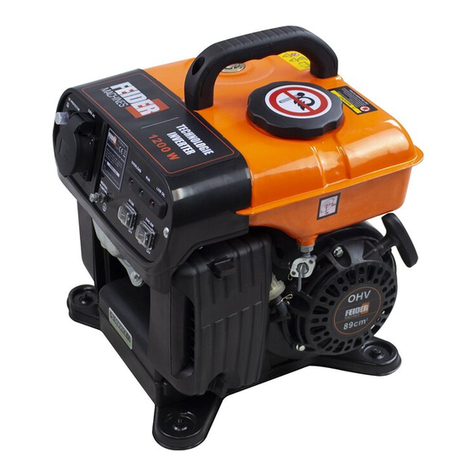
Feider Machines
Feider Machines FG1600i-A User guide
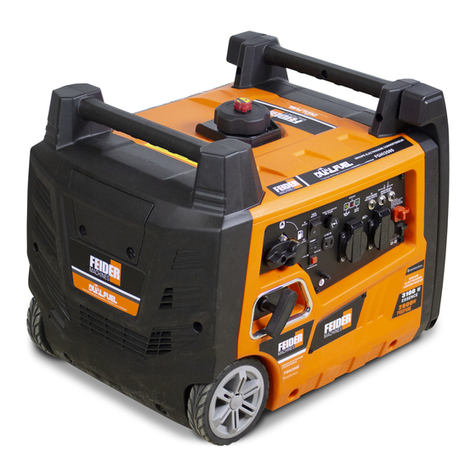
Feider Machines
Feider Machines FGHi3500 User manual
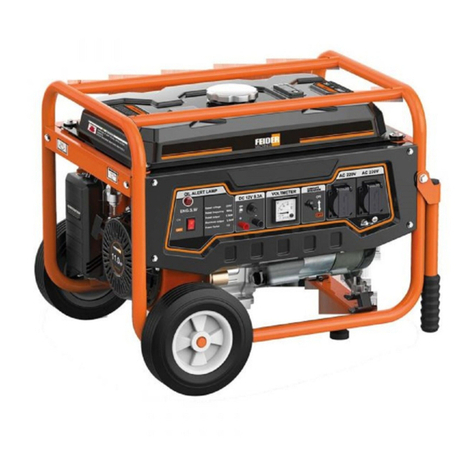
Feider Machines
Feider Machines FG4500-1 User manual
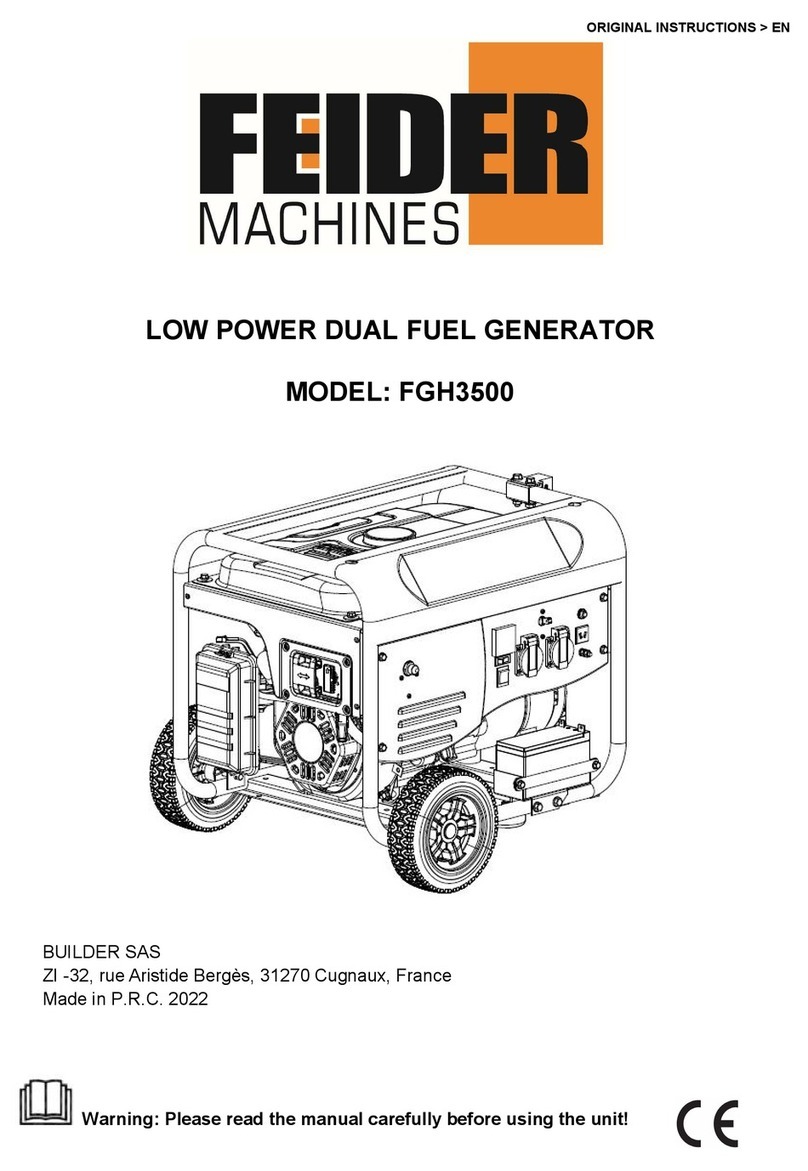
Feider Machines
Feider Machines FGH3500 User manual

Feider Machines
Feider Machines FG8500RS User manual

Feider Machines
Feider Machines FG1600i User manual
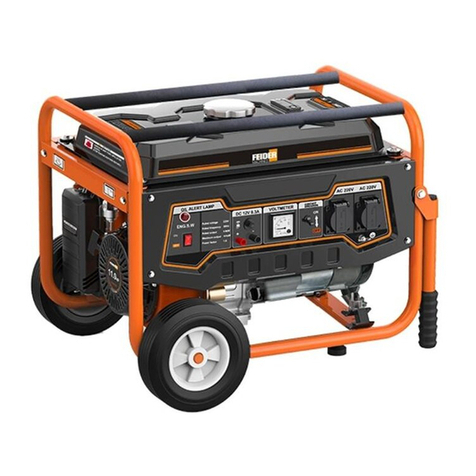
Feider Machines
Feider Machines FG4500 User manual
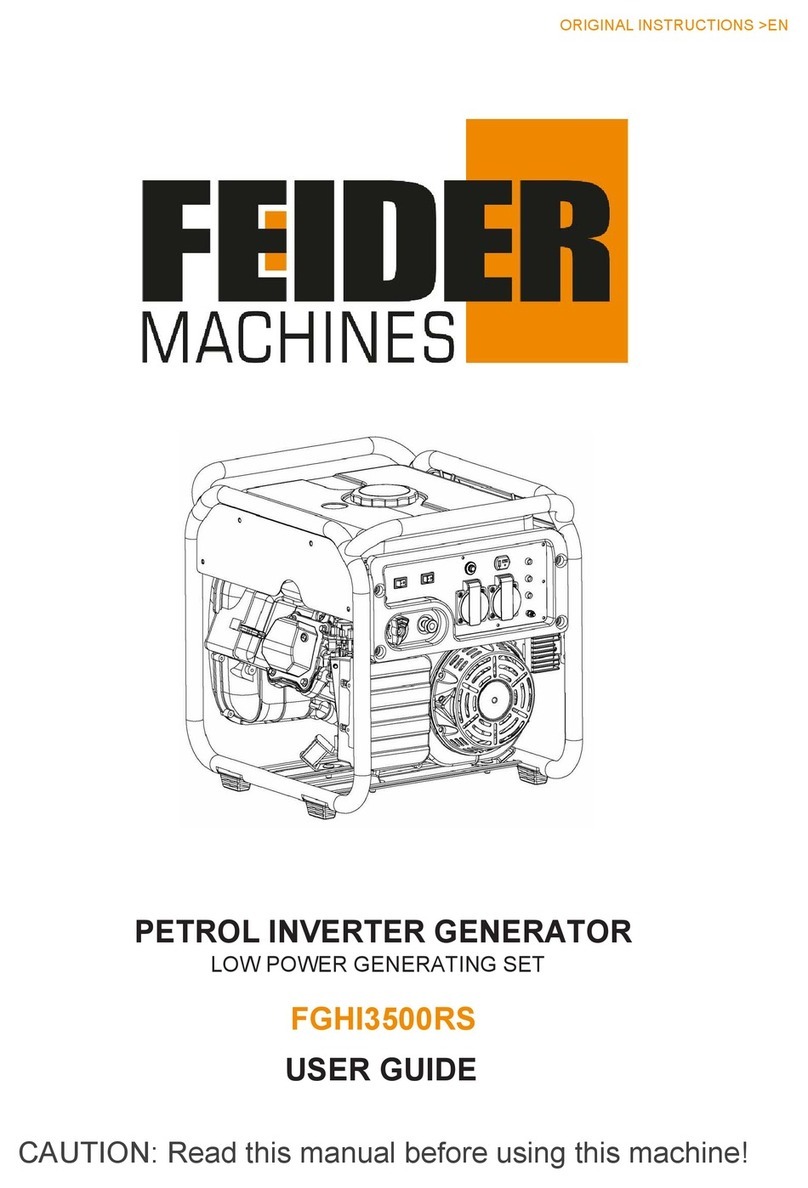
Feider Machines
Feider Machines FGHI3500RS User manual
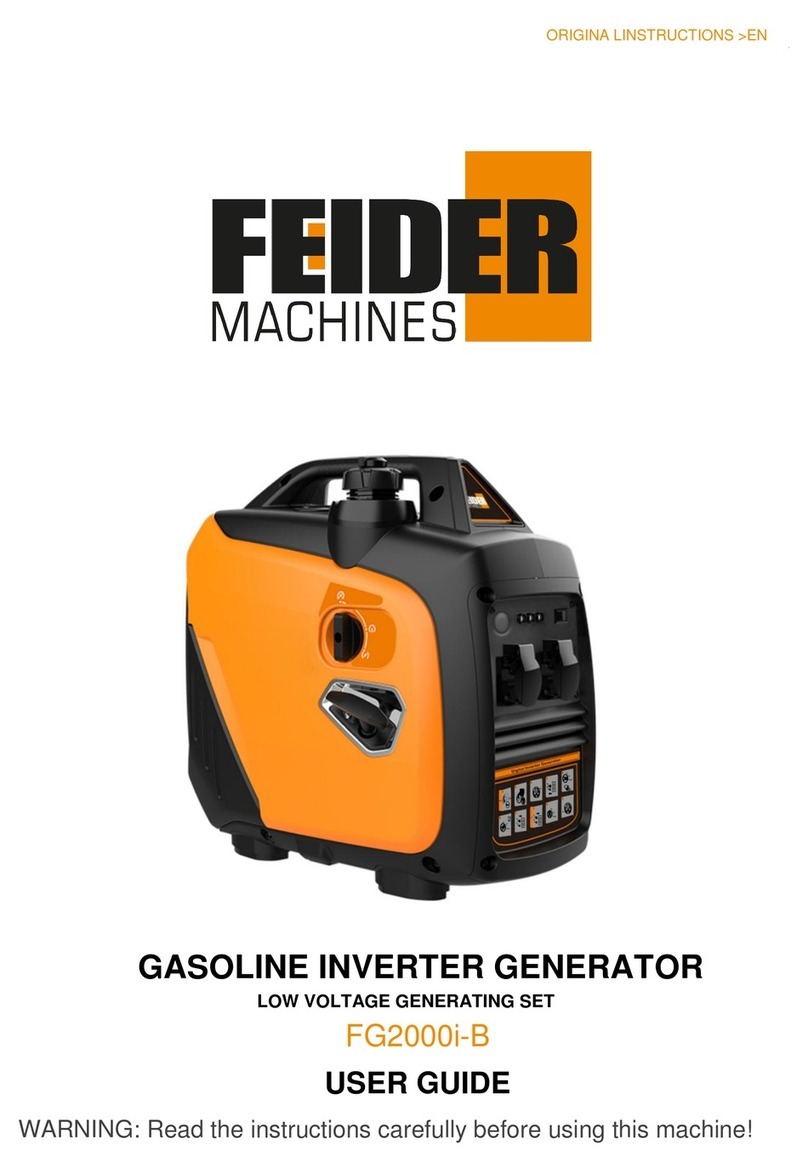
Feider Machines
Feider Machines FG2000i-B User manual
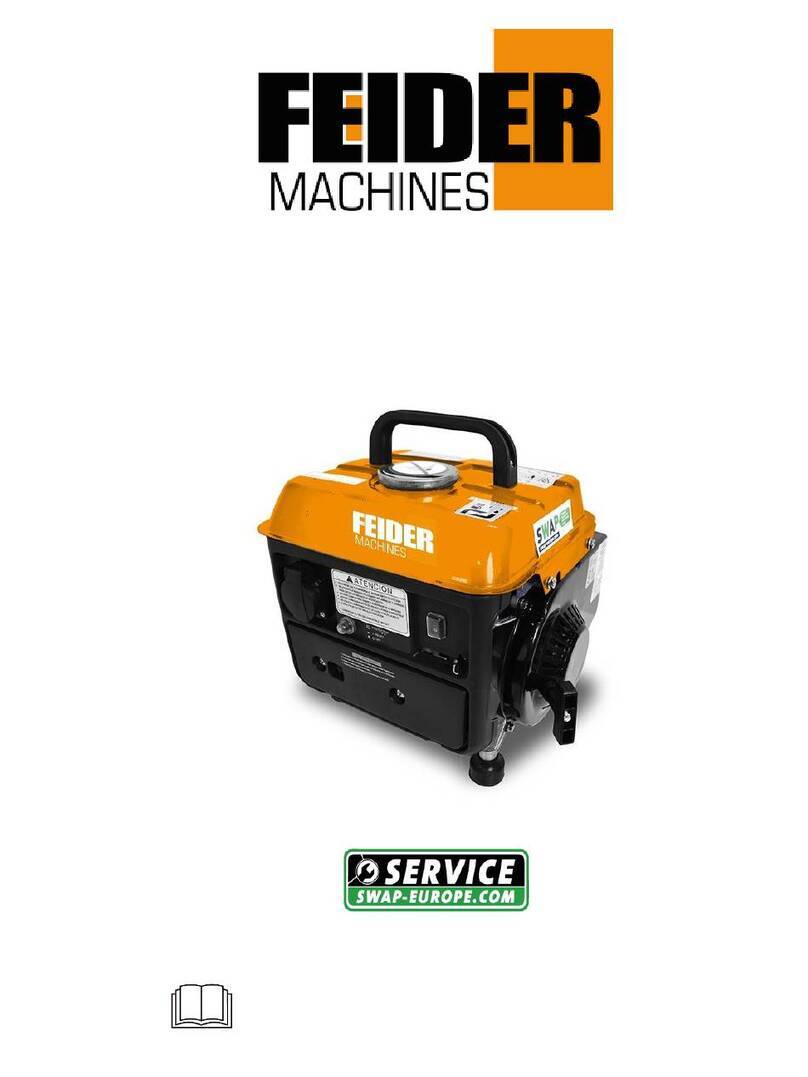
Feider Machines
Feider Machines FG800 User manual
